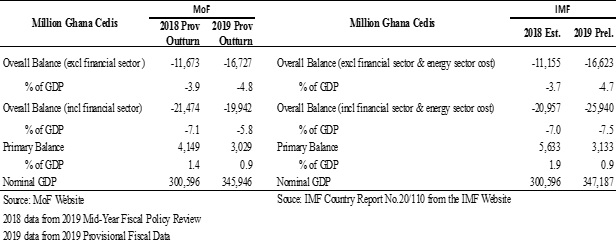Accra, 10th May, 2020 - Our attention has been drawn to a publication by fact-checkghana.com of the Media Foundation for West Africa suggesting that Government has shared different macroeconomic data with Ghanaians and the International Monetary Fund (IMF). We wish to state that this assertion is false and misleading.
May we state that the Ministry of Finance welcomes discussions of the economic information we provide. Such discussions help us in managing the economy. We also operate an open-door policy.
We urge the public to seek clarification on matters they may have difficulty with and we would be happy to help resolve any misunderstanding. Publishing such wrong claims about the economy is not helpful.
The first inaccuracy in the said publication was taking the January to September figures, that is the third quarter figures reported in our budget statements and comparing them with the full year figures reported by the IMF.
The fiscal deficit and primary balance reported in the publication are provisional end-September data quoted from the 2019 and 2020 Budget Statements. It was wrong to compare them with the full year figures reported by the IMF and come to the erroneous conclusion that Government had misrepresented information on the economy.
Here is the data: for the first three quarters of 2018 and 2019, the provisional fiscal deficit reported were 3.0% of GDP (2019 Budget Statement) and 4.5% of GDP (2020 Budget Statement), respectively while the primary balances were 0.5% of GDP (2019 Budget Statement) and -0.3% of GDP (2020 Budget Statement) respectively.
However, the full year fiscal outturn published on the Ministry of Finance website (www.mofep.gov.gh) indicate that the fiscal deficit was 3.9% of GDP for 2018 (Jan-Dec) and 4.8% of GDP for 2019 (Jan-Dec) while the primary balance recorded a surplus of 1.5% of GDP and 0.9% of GDP in 2018 and 2019 respectively.
Contrary to the claims in the publication, there is consistency between full-year fiscal performance indicators (overall fiscal balance and primary balance) reported by the Ministry of Finance and that reported by the IMF, even though both of them independently estimate their GDP projections based on independent assumptions. For the avoidance of doubt, Table 1 below depicts the level of consistency in the fiscal data as reported by both the MoF and IMF.
Table 1: Comparing MoF & IMF Reported Fiscal Performance for 2018 & 2019

Source: IMF website:
https://www.imf.org/en/Publications/CR/Issues/2020/04/16/Ghana-Request-for-Disbursement-Under-the-Rapid-Credit-Facility-Press-Release-Staff-Report-49337
Source: MoF
https://www.mofep.gov.gh/publications/budget-statements
It is also important to point out for public education that there may be some explained disparities between the data reported by national authorities and the IMF across the world. In Ghana’s case, differences between MoF and IMF data are mainly based on:
- whether the reported fiscal deficit includes or excludes extraordinary items such as financial sector bailout and energy sector contingent liabilities;
- whether the reported fiscal deficit includes or excludes Ghana Revenue Authority (GRA) retentions; and
- whether the fiscal deficit to GDP ratio is based on provisional or actual nominal GDP.
- Whether the assumptions underpinning reported projected GDP are the same or differs.
It is worthy of note that, just as Ghana did in our full year reports, the IMF in their Ghana Country Report (No.20/110), from which the Media Foundation quoted, both the “Overall balance” and “Overall balance excluding financial and energy sector related costs” have been reported. It is disingenuous for anybody to pick different variables for comparison. The Media Foundation should not do that.
With respect to the Current Account Balance and the Gross International Reserves, the data published by the Bank of Ghana (Summary of Economic and Financial Data) and the IMF (IMF Country Report No.20/110) are as follows:

BOG Website
https://www.bog.gov.gh/?s=summary+of+economic+and+financial
The data shows practically no discrepancy between the BoG and IMF on current account balance for 2018 and 2019.
On Gross International Reserves, differences could emanate from the treatment of petroleum funds (Ghana Stabilization Funds & Ghana Heritage Funds) in Gross International Reserves. Whiles the IMF data excludes petroleum funds, the Bank of Ghana data includes petroleum funds.
It is important to note that the reasons for these differences have been duly acknowledged by the IMF in the footnotes under each table in the IMF Staff Report on the Rapid Credit Facility (IMF Country Report No.20/110) from which the Media Foundation drew their claims.
We hope this addresses the misunderstanding and misinformation in the publication. Again, the doors of the Ministry of Finance are always open to those who may need clarification on information about Ghana’s economy. We thank you. END
ISSUED BY THE PUBLIC RELATIONS UNIT
MINISTRY OF FINANCE
THE NEWS EDITOR
